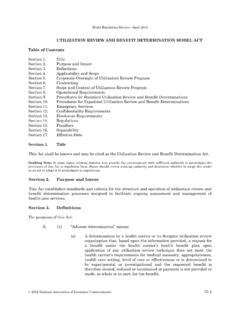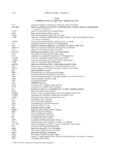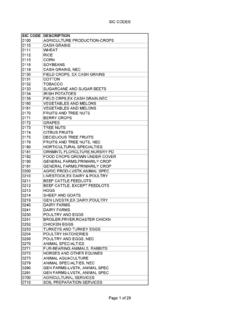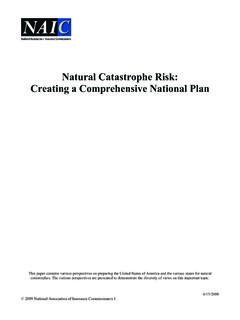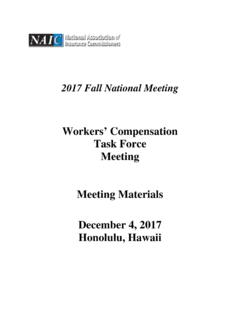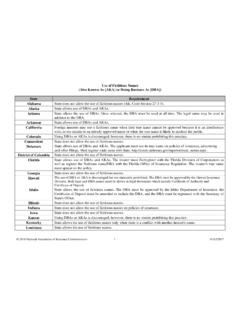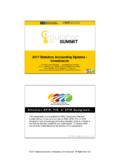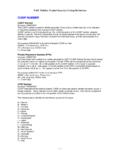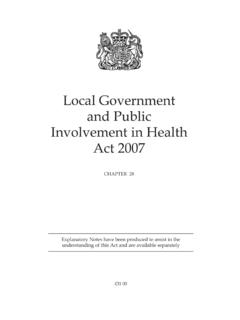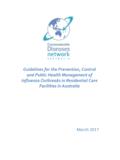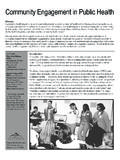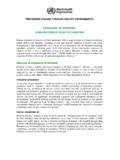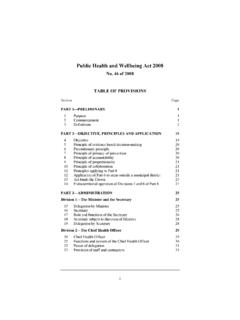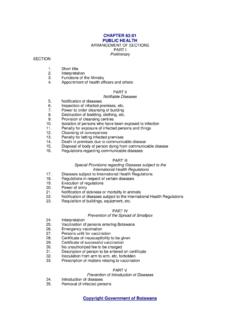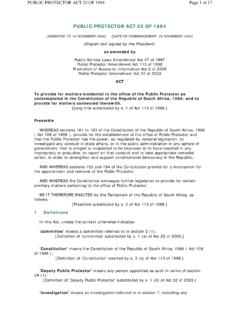Transcription of PUBLIC ADJUSTER LICENSING MODEL ACT Table of Contents
1 MODEL Regulation Service October 2005 2006 National Association of Insurance Commissioners 228-1 PUBLIC ADJUSTER LICENSING MODEL ACT Table of Contents Section 1. Purpose and Scope Section 2. Definitions Section 3. License Required Section 4. Application for License Section 5. Resident License Section 6. Examination Section 7. Exemptions from Examination Section 8. Nonresident License Reciprocity Section 9. License Section 10. Apprentice PUBLIC ADJUSTER License [Optional] Section 11. License Denial, Nonrenewal, or Revocation Section 12. Bond or Letter of Credit Section 13. Continuing Education Section 14. PUBLIC ADJUSTER Fees Section 15. Contract Between PUBLIC ADJUSTER and Insured Section 16. Escrow or Trust Accounts Section 17. Record Retention Section 18. Standards of Conduct of PUBLIC ADJUSTER Section 19.
2 Reporting of Actions Section 20. Regulations Section 21. Severability Section 22. Effective Date Section 1. Purpose and Scope This Act governs the qualifications and procedures for the LICENSING of PUBLIC adjusters. It specifies the duties of and restrictions on PUBLIC adjusters, which include limiting their licensure to assisting insureds in first party claims. Drafting Note: It is recommended that any statute or regulation inconsistent with this Act be repealed or amended. Drafting Note: This Act also requires a report to the insurance commissioner of any action in another jurisdiction against either the PUBLIC ADJUSTER license or licensee. Section 2. Definitions A. Apprentice PUBLIC ADJUSTER means the one who is qualified in all respects as a PUBLIC ADJUSTER except as to experience, education and/or training.
3 B. Business entity means a corporation, association, partnership, limited liability company, limited liability partnership or other legal entity. C. Catastrophic disaster according to the Federal Response Plan, means an event that results in large numbers of deaths and injuries; causes extensive damage or destruction of facilities that provide and sustain human needs; produces an overwhelming demand on state and local response resources and mechanisms; causes a severe long-term effect on general economic activity; and severely affects state, local and private sector capabilities to begin and sustain response activities. A catastrophic disaster shall be declared by the President of the United States or the Governor of the state or district in which the disaster occurred.
4 D. Fingerprints for the purposes of this act, means an impression of the lines on the finger taken for purpose of identification. The impression may be electronic or in ink converted to electronic format. PUBLIC ADJUSTER LICENSING MODEL Act 228-2 2006 National Association of Insurance Commissioners E. Home state means the District of Columbia and any state or territory of the United States in which the PUBLIC ADJUSTER s principal place of residence or principal place of business is located. If neither the state in which the PUBLIC ADJUSTER maintains the principal place of residence nor the state in which the PUBLIC ADJUSTER maintains the principal place of business has a substantially similar law governing PUBLIC adjusters, the PUBLIC ADJUSTER may declare another state in which it becomes licensed and acts as a PUBLIC ADJUSTER to be the home state.
5 F. Individual means a natural person. G. Person means an individual or a business entity. H. PUBLIC ADJUSTER means any person who, for compensation or any other thing of value on behalf of the insured: (1) Acts or aids, solely in relation to first party claims arising under insurance contracts that insure the real or personal property of the insured, on behalf of an insured in negotiating for, or effecting the settlement of, a claim for loss or damage covered by an insurance contract; (2) Advertises for employment as a PUBLIC ADJUSTER of insurance claims or solicits business or represents himself or herself to the PUBLIC as an PUBLIC ADJUSTER of first party insurance claims for losses or damages arising out of policies of insurance that insure real or personal property.
6 Or (3) Directly or indirectly solicits business, investigates or adjusts losses, or advises an insured about first party claims for losses or damages arising out of policies of insurance that insure real or personal property for another person engaged in the business of adjusting losses or damages covered by an insurance policy, for the insured. I. Uniform individual application means the current version of the National Association of Insurance Commissioners (NAIC) Uniform Individual Application for resident and nonresident individuals. J. [Optional] Uniform business entity application means the current version of the National Association of Insurance Commissioners (NAIC) Uniform Business Entity Application for resident and nonresident business entities.
7 Drafting Note: Subsection J is optional and would apply only to those states that have a business entity license requirement. Drafting Note: If any term is similarly defined in a relevant section of the state s insurance code, do not include the definition of the term in this Act or, in the alternative, reference the statute: [term] is defined in [insert appropriate reference to state law or regulation]. Section 3. License Required A. A person shall not act or hold himself out as a PUBLIC ADJUSTER in this state unless the person is licensed as a PUBLIC ADJUSTER in accordance with this Act. B. A person licensed as a PUBLIC ADJUSTER shall not misrepresent to a claimant that he or she is an ADJUSTER representing an insurer in any capacity, including acting as an employee of the insurer or acting as an independent ADJUSTER unless so appointed by an insurer in writing to act on the insurer s behalf for that specific claim or purpose.
8 A licensed PUBLIC ADJUSTER is prohibited from charging that specific claimant a fee when appointed by the insurer and the appointment is accepted by the PUBLIC ADJUSTER . C. A business entity acting as a PUBLIC ADJUSTER is required to obtain a PUBLIC ADJUSTER license. Application shall be made using the Uniform Business Entity Application. Before approving the application, the insurance commissioner shall find that: (1) The business entity has paid the fees set forth in [insert appropriate reference to state law or regulation; and (2) The business entity has designated a licensed PUBLIC ADJUSTER responsible for the business entity s compliance with the insurance laws, rules and regulations of this state. MODEL Regulation Service October 2005 2006 National Association of Insurance Commissioners 228-3 Drafting Note: Subsection C is optional and would apply only to those states that have a business entity license requirement.]
9 D. Notwithstanding subsection A through C, a license as a PUBLIC ADJUSTER shall not be required of the following: (1) An attorney-at-law admitted to practice in this state, when acting in his or her professional capacity as an attorney; (2) A person who negotiates or settles claims arising under a life or health insurance policy or an annuity contract; (3) A person employed only for the purpose of obtaining facts surrounding a loss or furnishing technical assistance to a licensed PUBLIC ADJUSTER , including photographers, estimators, private investigators, engineers and handwriting experts; (4) A licensed health care provider, or employee of a licensed health care provider, who prepares or files a health claim form on behalf of a patient; or (5) A person who settles subrogation claims between insurers.
10 Section 4. Application for License A. A person applying for a PUBLIC ADJUSTER license shall make application to the commissioner on the appropriate uniform application or other application prescribed by the commissioner. B. The applicant shall declare under penalty of perjury and under penalty of refusal, suspension or revocation of the license that the statements made in the application are true, correct and complete to the best of the applicant s knowledge and belief. C. In order to make a determination of license eligibility, the insurance commissioner is authorized to require fingerprints of applicants and submit the fingerprints and the fee required to perform the criminal history record checks to the state identificationbureau (or state department of justice PUBLIC state agency) and the Federal Bureau of Investigation (FBI) for state and national criminal history record checks; the insurance commissioner shall require a criminal history record check on each applicant in accordance with this Act.
